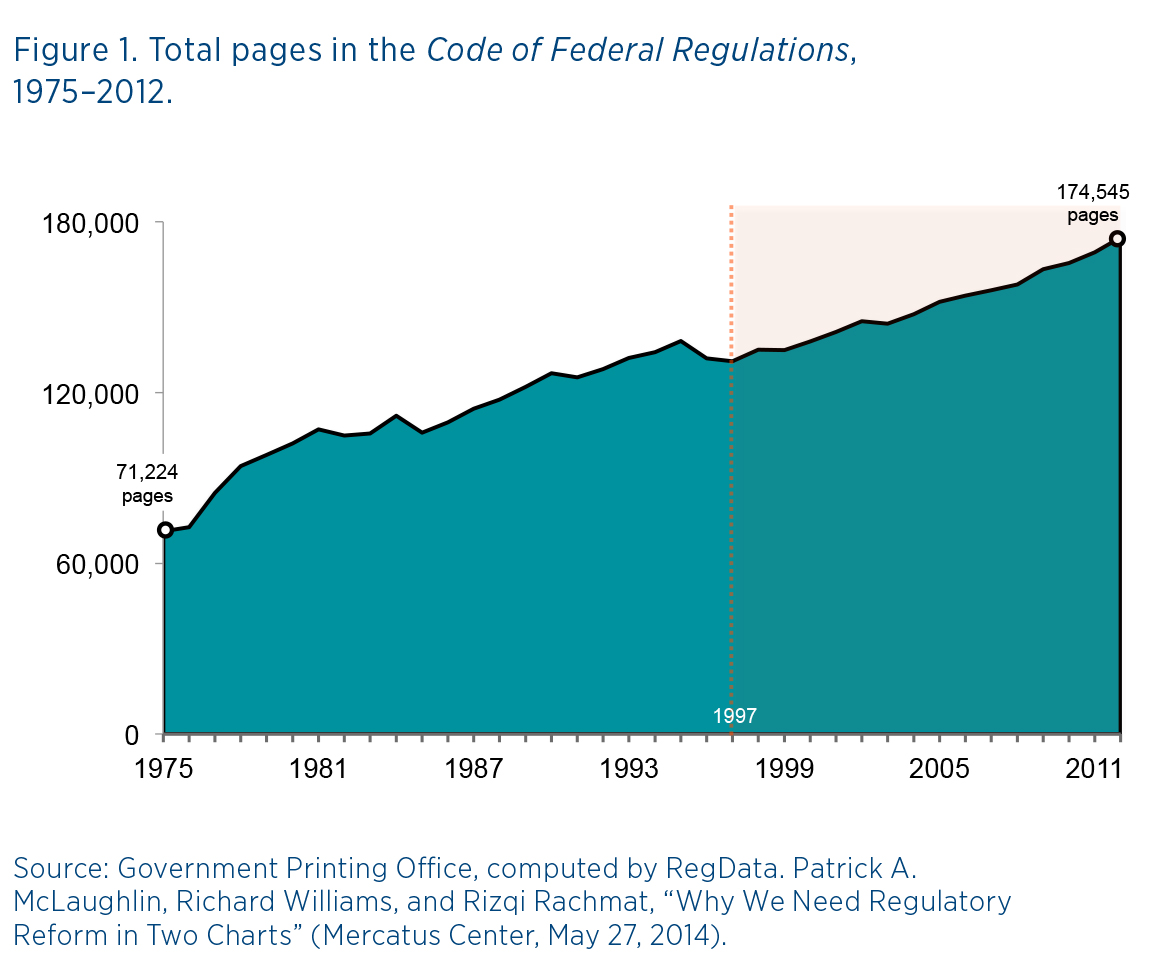- | Regulation Regulation
- | Policy Briefs Policy Briefs
- |
Regulatory Impact Analysis: Four Decades of Foibles
On the eve of its abolition in 1981, the Council on Wage and Price Stability (CWPS) pointed out that regulations were often imposed without a clear understanding of the problem they were supposed to solve, a realistic examination of a range of options for solving the problem, and a benefit-cost analysis of each option.
On the eve of its abolition in 1981, the Council on Wage and Price Stability (CWPS) pointed out that regulations were often imposed without a clear understanding of the problem they were supposed to solve, a realistic examination of a range of options for solving the problem, and a benefit-cost analysis of each option.1
These deficiencies in agency analysis have persisted despite the best efforts of the Office of Information and Regulatory Affairs (OIRA), which began reviewing regulations in 1981. Regulatory process reform is necessary to ensure that regulations address proven problems, solve a substantial portion of those problems, and do so at an acceptable cost.
LONGSTANDING AGREEMENT ON ANALYSIS STANDARDS
As table 1 shows, executive orders issued by every president since Jimmy Carter have consistently identified key elements agencies should include in their Regulatory Impact Analyses (RIAs). These elements include:
1. Assessing the nature and significance of the problem the agency is trying to solve, so the agency knows whether there is a problem that could be solved through regulation and, if so, the agency can tailor a solution that will effectively solve it.
2. Identifying a wide variety of alternative solutions.
3. Defining the benefits the agency seeks to achieve in terms of ultimate outcomes that affect citizens’ quality of life and assessing each alternative’s ability to achieve those outcomes.
4. Identifying the good things that regulated entities, consumers, and other stakeholders must sacrifice in order to achieve the desired outcomes under each alternative. In economics jargon, these sacrifices are known as “costs,” but just like benefits, costs may involve far more than monetary expenditures.2
LONGSTANDING DEFICIENCIES IN ANALYSIS
During the past four decades, agencies have failed to follow the rulemaking standards enunciated in these executive orders.
CWPS Filings
Between 1974 and 1981, CWPS analyzed proposed regulations and submitted its analysis to agencies during the public comment period. A new historical review notes, “The majority of CWPS filings included at least one of the following conclusions: the regulatory agency either failed to estimate benefits or had done so incorrectly, the agency either failed to estimate costs or had done so incorrectly, and the agency should have examined different regulatory options.”3
Consider, for example, the CWPS analysis of a regulation proposed by the Department of Transportation in 1978 that would have changed the maximum duty and driving hours for commercial truck and bus drivers. CWPS noted that, despite Executive Order 12044’s requirement that agencies consider several alternatives, the regulators did not consider whether alternative approaches might produce greater benefits or lower costs.4 The CWPS comments urged regulators to consider alternatives, such as stricter enforcement of the current rules, increased driver training, improved truck cab safety, more spot safety checks, and highway improvements.5
POST-1981 EVALUATIONS OF RIAS
Despite the advent of OIRA review in 1981, Government Accountability Office studies and scholarly research reveal that in many cases, RIAs are not sufficiently complete to guide agency decisions.6 The most recent evaluations of agency RIAs, from the Mercatus Center’s Regulatory Report Card, confirm those earlier findings.7 The Report Card project has assessed all RIAs for economically significant, prescriptive regulations proposed between 2008 and 2012.8 The project found some reasonably good examples of the proper execution of each key aspect of regulatory impact analysis.9 However, the average RIA did a poor job of assessing the problem the agency sought to solve and a mediocre job of assessing benefits, costs, and alternatives.10
Regulations restricting truckers’ service hours again illustrate longstanding problems with RIAs. A proposed 2010 regulation that would have reduced service hours was accompanied by an RIA that estimated the benefits and costs of alternatives, but the alternatives consisted of “no new regulatory action” plus three options that were all narrow variations on the same basic approach. All of the options reduced duty time and required a break but had different limits on driving time.11 Moreover, the agency identified no market failure that would prevent companies and drivers from internalizing the costs of fatigue. It admitted that the data show prior changes in hours of service regulations have had no effect on highway safety, and indeed, the total number of crashes is declining.12
IMPORTANCE OF REGULATION CONTINUES TO GROW
Although regulatory analysis is often seriously incomplete, the scope of regulation continues to expand. Figure 1 shows that the total number of pages in the Code of Federal Regulations has more than doubled during the period of regulatory review that commenced with CWPS and continued under OIRA. Given the extensive effects of regulation on all Americans’ lives, there is no excuse for agencies not to understand the problems they seek to solve and the benefits and costs of alternative solutions.
INSTITUTIONAL REFORM IS THE SOLUTION
Mercatus Center scholars have identified several institutional reforms to prevent future regulatory failures and correct existing regulations that have not produced the desired outcomes.
Require Regulatory Impact Analysis by Statute.
Agencies should perform proper analysis on potential regulations, but they frequently fail to meet long-standing quality standards. Too often, agencies misuse analysis as a means to justify predetermined decisions rather than as a tool to inform decision-making.13 To foster better analysis, Congress should mandate regulatory analysis by statute, with judicial review to ensure that the analysis meets minimum quality standards and that the agency adequately explained how the analysis affected its decisions.
Apply the Same Analysis Standards to Executive Branch and Independent Agencies.
Executive orders requiring federal regulatory analysis do not apply to independent agencies. Scholarly research has found that many independent agencies conduct even less thorough economic analysis than executive branch agencies.14 To better serve the public interest, Congress should ensure all agencies are subject to the same requirements for regulatory analysis, including review by OIRA.15
Correct Nonfunctional Rules.
Numerous rules have accumulated that did not undergo thorough analysis at the time they were implemented. Consequently, many regulations are likely “nonfunctional.” A nonfunctional rule is a rule that does not address a current, significant problem; fails to mitigate a significant portion of the problem; or has significant unintended effects or excessive compliance costs relative to its benefits.16 Presidents have often required agencies to conduct retrospective analysis of existing rules, but requiring agencies to critically examine their own rules has produced meager results.17
As a result, congressional action may be required to address the problem of nonfunctional rules.
One promising approach is an expert regulatory review commission, modeled after the Base Realignment and Closure Commission used to consolidate and close military bases since 1988. This independent commission would conduct assessments of regulatory programs based on objective criteria specified in the legislation. Its package of recommendations for modifying or repealing regulations would take effect unless disapproved by Congress.18
These three reforms would help ensure that both new and existing rules receive the thorough scrutiny that was promised, but not always achieved, by executive orders.




